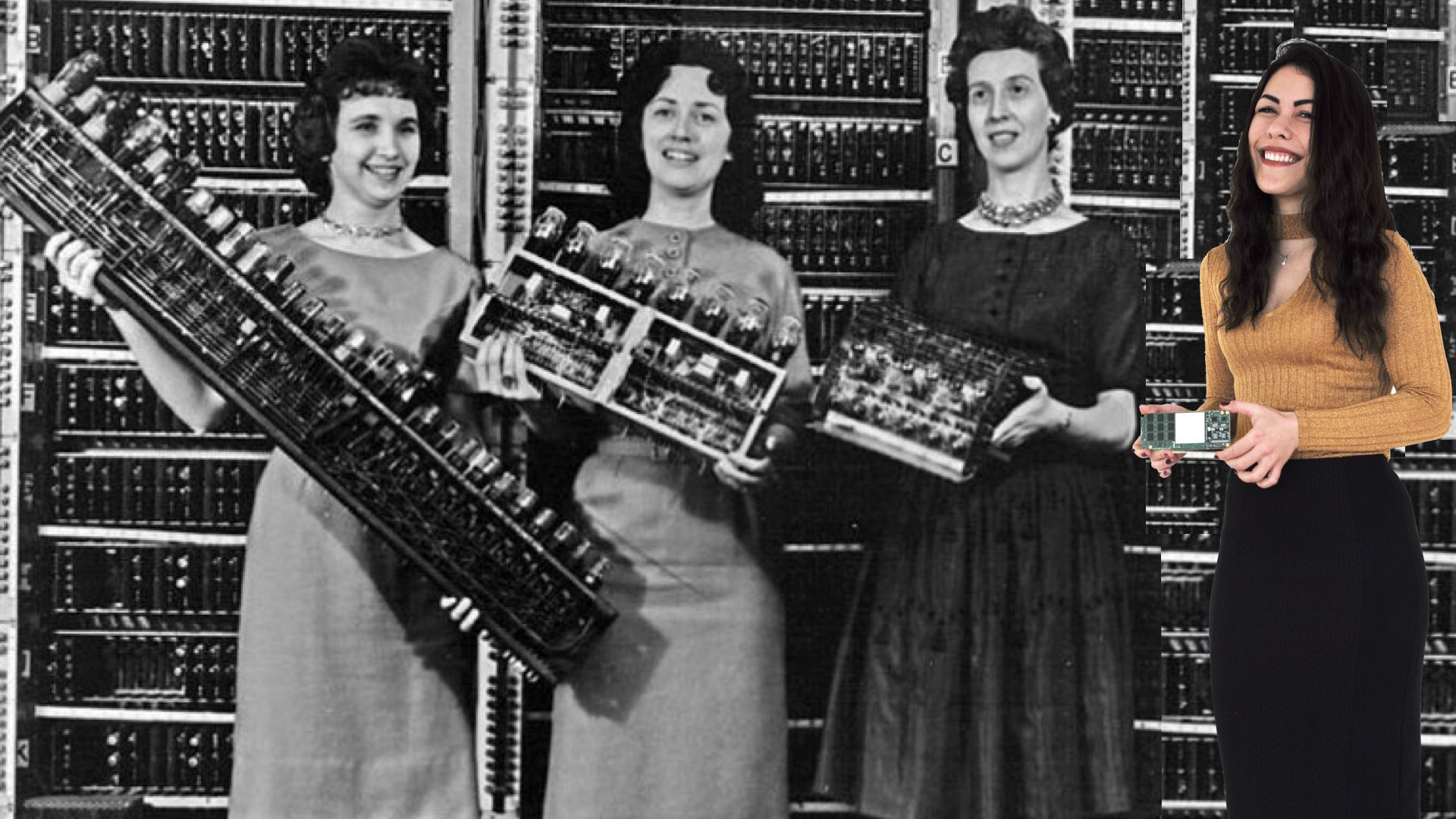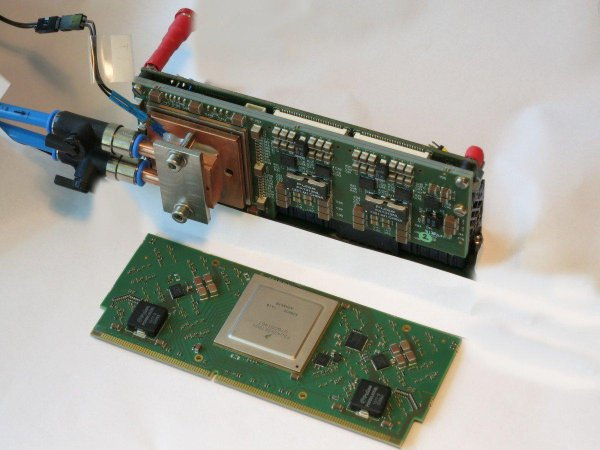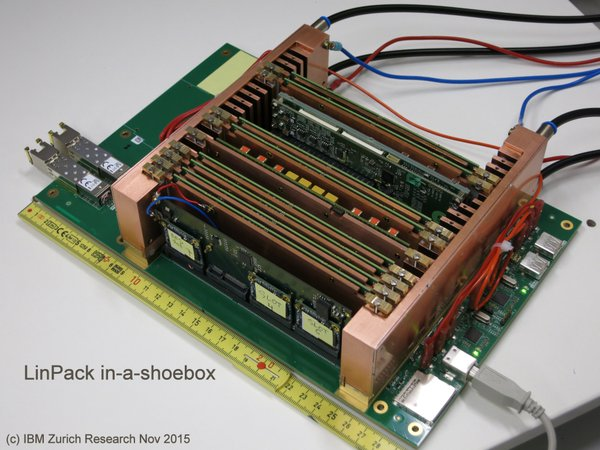IBM and ASTRON introduce
Award-winning 64-bit MicroDataCenter prototype prepares for Big Bang Big Data
Water-cooled, energy-efficient microserver will analyze petabytes of data daily

Comparing our T4240ZMS MicroServer to the 1950s.
The microserver’s team has designed and demonstrated a prototype 64-bit microserver using a PowerPC based chip from Freescale Semiconductor running Linux Fedora and IBM DB2. At 133 × 55 mm2 the microserver contains all of the essential functions of today’s servers, which are 4 to 10 times larger in size. Not only is the microserver compact, it is also very energy-efficient.
One of its innovations is hotwater cooling, which in addition to keeping the chip operating temperature below 85°C, will also transport electrical power by means of a copper plate.
The concept is based on the same technology IBM developed for the SuperMUC supercomputer located outside of Munich, Germany. IBM scientists hope to keep each microserver operating between 35–40 watts including the system on a chip (SOC) — the current design is 60 W.
The next step for scientists is to begin to take 128 of the microserver boards using the newest T4240 chips to create a 2U rack unit with 1536 cores and 3072 threads with up to 6 terabytes of DRAM.
In addition, they will be adding an Ethernet switch and power module to the integrated water-cooling.
“I like to call it a datacenter in a shoebox. With the combination of power and energy efficiency, we believe the microserver will be of interest beyond the DOME project, particularly for cloud data centers and Big Data analytics applications.”
—Ronald Luijten, Data motion architect, IBM Research

Ronald Luijten
IBM Research scientist
Collaboration
We are currently working intensively with ILA microservers, a startup company in The Netherlands, to commercialize our technology.
Square Kilometre Array
An international consortium to build the world’s largest and most sensitive radio telescope
IBM and the Netherlands Institute for Radio Astronomy ASTRON have unveiled the world’s first water-cooled 64-bit microserver.
The prototype, which is roughly the size of a smartphone, is part of the proposed IT roadmap for the Square Kilometre Array.
Scientists estimate that the processing power required to operate the SKA telescope will be equal to several millions of today’s fastest computers.
When it goes live by 2024, the SKA will collect a deluge of radio signals from deep space. To do so, thousands of antennas located in southern Africa and Australia will collectively gather 14 exabytes of data and store one petabyte every day. The SKA has been called the ultimate Big Data challenge.
To solve this unprecedented challenge, ASTRON and IBM scientists have launched an initial five-year, 35.9 M euro collaboration in 2012 called DOME, named for the protective cover on telescopes and the famous Swiss mountain.
“With the SKA we will be able to fill big gaps in our knowledge of the universe. We’ll be able to map the so-called ‘dark ages,’ the epoch of reionization, when the stars and galaxies formed.”
—Albert-Jan Boonstra, scientific director of ASTRON
Based on the distributed design of the SKA, with a total antenna area of one square kilometer, and owing to the large volume of Big Data collected, a high-performance computing architecture with data transfer links with a capacity that far exceeds current state-of-the-art technology must be developed to manage the process of gathering, storing and analyzing the 13 billion year old data from end to end.
DOME is investigating and developing an emerging technologies roadmap for large-scale and efficient exascale computing, data transport and storage processes based on a data-centric computing model. Part of this roadmap includes a densely packed, highly efficient microserver which integrates a traditional server motherboard without the memories on a chip.
IBM and ASTRON recently announced the launch of the European Research Center for Exascale Technology (ERCET) with the University of Groningen. The DOME project will be included in ERCET along with projects focused on Big Data applications in energy, healthcare and water management.

Rendering of the DOME MicroDataCenter with 64 microservers, two integrated switches, power supply and water cooling.

This 90-second video shows ZRL scientists automatically booting all 8 nodes of the MicroDataCenter prototype.
IBM scientist Ronald Luijten (@ronaldgadget) presents the microserver at ASTRON’s offices in Dwingeloo, The Netherlands
They said it couldn’t be done...
Downloads
The Energy-Efficient, High-Performance 64-bit DOME μserver: An Industry Inclination Point
64-bit μserver Demonstrator: Findings, Status, Outlook
Podcast: Matteo Cossale at CeBIT 2015
Fedora boots first time on Zurich T4240 microserver
Paper presentation and live demo at ISSCC2015, San Francisco on Feb 23rd
Presentation: The ASTRON / IBM 64 bit μServer for SKA, SC14 Emerging Technologies
Web page hosted by DOME microserver
Press articles
Variass to manufacture 64-bit microservers developed by ASTRON and IBM, ASTRON
Big Data with Space and Sound, Oxford e-Research Centre
Ultra Low-Power Microserver to Tackle Big Bang Program’s Energy Needs, Wired
IBM DOME Microserver Could Appeal To Enterprises, EnterpriseTech
Big Science, Tiny Microservers: IBM Research Pushes 64-Bit Possibilities, HPC Wire